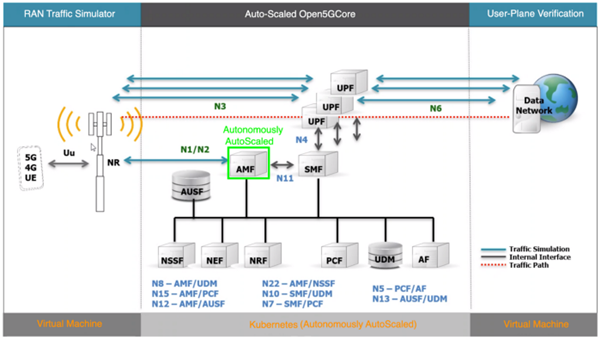
Red Hat: Testing Kubernetes and hyperscalers on an Emblasoft-emulated 5G Core
Red Hat: Testing Kubernetes and hyperscalers on an Emblasoft-emulated 5G Core
Emblasoft’s new Evolver platform for 5G active monitoring and assurance, and automated functional and load testing, has just been used by Red Hat to test the scaling capabilities of Kubernetes in an emulated 5G Standalone (SA) Core, with fascinating results.
Emblasoft has just participated in a recent Red Hat project to test the scaling capabilities of the open-source system Kubernetes, also known as K8s – which is used for automating deployment, scaling, and management of containerised applications. The test was run as the latest in a series of broader tests performed by Red Hat’s Solutions Architect and Chief Architect, Fatih Nar and Federico Rossi, respectively.
A further purpose of the test was to develop a purpose-built and verified industrial solution blueprint that could help to accelerate industry adoption of microservices in a cloud environment. In turn, this could accelerate time to market and lower the risks involved in launching new cloud-native services.
Red Hat believes that platform software companies working closely with hyperscalers – operators of data centres that link server computing resources horizontally to deliver the promise of cloud computing for telecom workloads – can help enterprises to unchain themselves and massively scale resources within a highly distributed, complex 5G architecture.
Testing Kubernetes in a highly distributed, emulated 5G Core
Telecommunications and media solutions are widely distributed systems over multiple geo-locations, allowing them to reach a greater consumer base, be it human subscribers or machine to machine systems. But K8s came out of the enterprise data centre and was not specifically designed to run in a highly distributed, complex 5G environment, hence the project to discover its true capabilities.
This latest Red Hat-Emblasoft project focused on the scalability side of the 5G technology stack using Kubernetes constructs (replica sets, metrics-driven pod auto-scaling, and more) together with multi-cluster management facilities introduced through K8s API and the CNCF open cluster management project[1].
The authors tested and verified the solution architecture and design paradigms in a testbed running on hyperscaler infrastructure with K8s as the de facto 5G platform leveraging existing 5G toolbox components to load the test-deployment and observe the outcomes of the scalability design (see Figure 1).
Figure 1: Testbed setup

Source: Red Hat
As shown, the entire setup was made possible using Emblasoft-enabled emulation of the RAN side, which generated a 5G gNB attachment, as well as user equipment (UE) registration traffic towards 5G core CNFs deployed on the K8s platform running on hyperscaler infrastructure.
In addition, the user-plane verification side ensured that the attached UE(s) had an internet breakout over the 5G Core, which also created additional load/stress for CNF(s).
The Emblasoft-emulated traffic made it possible for the autonomous 5G Core platform to scale up and down based on user/consumer demand, a feature which is designed to optimise infrastructure costs for OPEX, without sacrificing user experience – an essential test to perform.
The test revealed some fascinating results. To read the full article, and find out how the system performed, please click this link.